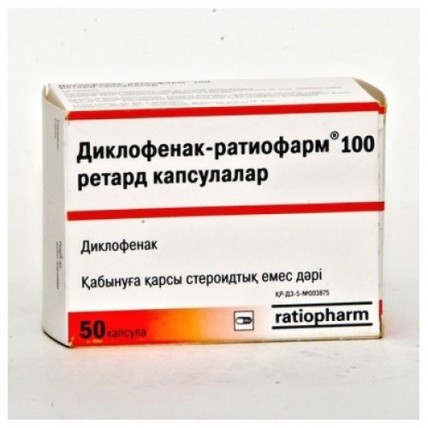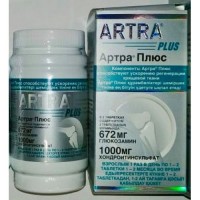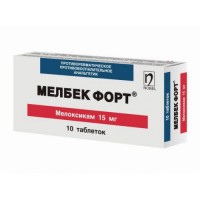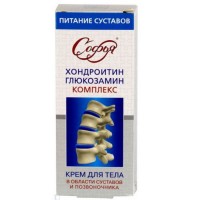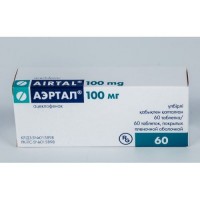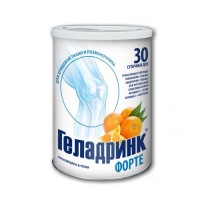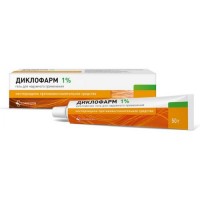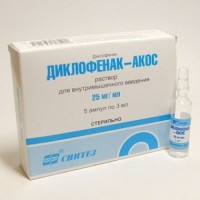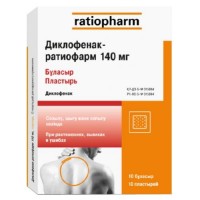Diclofenac-ratiopharm 100 mg (50 capsules)
- $20.00
The instruction for medical use of Diklofenak-ratiopharm Torgovoye medicine a name of Diklofenak-ratiopharm the International unlicensed name Diclofenac Dosage Form of the Capsule kishechnorastvorimy, 100 mg Structure One capsule contains active agent - diclofenac of sodium of 100.0 mg, excipients: lactoses monohydrate, cellulose microcrystalline, cellulose microcrystalline and sodium carboxymethylcellulose, glycerin trimyristate, the titan dioxide (E 171), trietit citrate, silicon dioxide colloidal water, ammonium methacrylate a kopolimer type B (Eudragit of RS 30 D), structure of a cover *: the titan dioxide (E 171), ferrous oxide yellow (E 172), ferrous oxide red (E 172), gelatin, water purified. * Composition of paint of the press on the body and a cover: INK 1 (10A1 black): shellac glaze – 45% (20% are esterified) in ethanol, ferrous oxide black (E 172), propylene glycol (E1520), ammonium hydroxide of 28%. INK 2 (10A2 black): shellac, propylene glycol, solution of ammonium of hydroxide, potassium hydroxide, ferrous oxide black (E 172). The description Solid gelatin capsules, with the colourless transparent body with Diclo press. ret. and a cover of orange color with Diclo press. ret. Contents of capsules: white or pale yellow granules. Pharmacotherapeutic Musculoskeletal system group. Anti-inflammatory and antirheumatic drugs. Anti-inflammatory and antirheumatic drugs, nonsteroid. Acetic acid derivative and related substances. Diclofenac. ATH M code 01AB 05 the Pharmacological Pharmacokinetics Later properties of intake the maximum concentration of diclofenac in blood is reached on average in 2.5-3 hours. Diclofenac contacts blood albumine for 99%. Gets into synovial fluid. It is metabolized in a liver. 60% of drug are removed by kidneys in the form of metabolites, less than 1% - in not changed look, the rest is removed in the form of metabolites with bile. The pharmacodynamics of Diklofenak-ratiopharm belongs to non-steroidal anti-inflammatory drugs. Renders expressed the anti-inflammatory, anesthetizing and moderate febrifugal action. The mechanism of effect of diclofenac is caused by suppression of activity of enzyme of cyclooxygenase therefore reactions of an arachidonic cascade are blocked and synthesis of PGE2, PGF2α prostaglandins, A2 thromboxane, prostacyclin, leukotrienes and emission of lizosomalny enzymes which play a major role in pathogenesis of inflammation, pain and fever is broken. Diclofenac suppresses aggregation of thrombocytes. In rheumatic diseases diclofenac reduces a joint pain at rest and at the movement, morning constraint, a swelling of joints, improves their functional capacity. At the inflammatory processes arising after operations and injuries quickly facilitates both spontaneous pain, and an oxycinesia, reduces inflammatory hypostasis on the place of a wound. Indications - acute arthritises of various genesis (including, gout) - chronic arthritises, including a pseudorheumatism, juvenile chronic polyarthritis - an ankylosing spondylitis (Bekhterev's disease) and other spondylarthrites - arthroses and spondylarthroses (degenerative diseases of joints and a backbone) - rheumatic defeats of soft tissues - painful hypostasis and inflammations of soft tissues of the musculoskeletal system after injuries and surgeries - not rheumatic inflammatory states which are followed by a pain syndrome. Because of the slowed-down release of active substance, this dosage form should not be applied at the states demanding fast establishment of effect of drug. The route of administration and doses take the Drug inside, without chewing, with enough liquid directly to or at the beginning of meal. Diklofenak-ratiopharm appoint the adult once a day. Duration of treatment is established by the attending physician depending on features of a course of the disease and weight of a state. In rheumatic diseases the drug treatment can be long. Side effects Undesirable reactions are classified by frequency, the most often found reactions are specified the first: very often: (& gt, 1/10), it is frequent (≥ 1/100, & lt, 1/10), infrequently (≥ 1/1000, & lt, 1/100), is rare (≥1/10000, & lt, 1/1000), is very rare (& lt, 1/10000), it is unknown: it cannot be estimated on the available data. The following undesirable effects include the reactions registered at short-term or long-term use. Very often - nausea, vomiting, diarrhea Often - a headache, dizziness, irritability, fatigue - vertigo or true dizziness - dyspepsia, a meteorism, an abdominal pain, anorexia, gastrointestinal ulcers (in certain cases with bleeding and a perforation) - rash, an itching - increase in level of transaminases Is rare - drowsiness, fatigue - asthma (including an asthma) - hypersensitivity, anaphylactic and anaphylactoid reactions (including hypotension and shock) - gastritis, gastrointestinal bleedings, a hematemesis, hemorrhagic diarrhea, a melena, gastrointestinal ulcers with or without bleeding or perforation (sometimes from the death especially at elderly people) - hepatitis, jaundice, an abnormal liver function - urticaria - irritation in the injection site, swell Very seldom - a disorientation, a depression, insomnia, a nightmare, irritability, psychotic disorders - paresthesia, disturbance of memory, a spasm, uneasiness, a tremor, aseptic meningitis, disturbance of taste, disturbance of cerebral circulation - a disorder of vision, illegibility of sight, a diplopia - sonitus, a hearing disorder - heartbeat, a stethalgia, heart failure, a myocardial infarction - a hypertension, hypotonia, a vasculitis - thrombocytopenia, a leukopenia, anemia (including hemolytic and aplastic anemia), an agranulocytosis - a Quincke's disease (including a face edema) - a pneumonitis - colitis (including hemorrhagic colitis and exacerbation of ulcer colitis or Crohn's disease), a constipation, stomatitis (including a stomacace), a glossitis, dysfunction of a gullet, a diafragmopodobny intestinal stenosis, pancreatitis - lightning hepatitis, liver necrosis, a liver failure - violent rashes, eczema, an erythema, a multiformny erythema, Stephens-Johnson's syndrome, a toxic epidermal necrolysis (Lyell's disease), exfoliative dermatitis, a hair loss, reactions of photosensitivity, purple, an allergic purpura, an itching - an acute renal failure, a hamaturia, a proteinuria, a nephrotic syndrome, interstitial nephrite, renal papillary necrosis - impotence It is unknown - confusion of consciousness, a hallucination, disturbance of sensitivity, a general malaise - the optic neuritis Diclofenac slows down aggregation of thrombocytes that demands constant control of a hemostasis from patients with disturbances of blood clotting. - reactions of hypersensitivity to diclofenac in the form of a face edema, swelling of language, swelling of a throat with narrowing of air ways, breath difficulty, up to an attack of asthma and threat of shock - deterioration in a course of the inflammatory processes caused by an infection (for example, development of a necrotizing fascitis). It is perhaps connected with the mechanism of effect of non-steroidal anti-inflammatory drugs. Therefore if at use of diclofenac there are symptoms of an infection or deterioration in already available infectious disease, urgent medical inspection for the purpose of detection of indications is necessary for therapy by antibiotics. - other side effects: peripheral swell, it is rare - heartbeat, stethalgias, increase in blood pressure, heart failure. Diclofenac, especially in high doses (150 mg/days) and at prolonged use, can increase several risk of developing of an arterial thrombembolia (for example: myocardial infarction or stroke). Contraindications - hypersensitivity to diclofenac, or to other components of medicine - patients at whom intake of non-steroidal anti-inflammatory drugs provokes: attacks of bronchial asthma, a Quincke's edema, a small tortoiseshell, acute rhinitis - an erosive canker of a stomach and/or intestines (not less than 2 episodes of an ulcer or bleeding) - gastrointestinal bleeding or a perforation in connection with the previous reception of NPVP - Inflammatory bowel diseases (such as Crohn's disease, ulcer colitis) - disturbances of a picture of blood of not clear genesis - cerebrovascular go other active bleeding - stagnant heart failure (NYHA II-IV), coronary heart disease, diseases of peripheral arteries or cerebrovascular diseases - heavy heart failure - a heavy renal failure (KK less than 30 ml/min.) - a heavy liver failure - the III trimester of pregnancy, the lactation period - children's and teenage age up to 18 years - the lactose intolerance, deficiency of lactase, glucose galactose malabsorption Medicinal interactions the Following interactions are noted at diclofenac use. Lithium: diclofenac can increase concentration of lithium in blood plasma. Monitoring of level of lithium in blood plasma is recommended. Digoxin: diclofenac can increase concentration of digoxin in blood plasma. Monitoring of levels of digoxin in blood plasma is recommended. Diuretics and antihypertensive drugs (for example blockers of β-adrenoceptors, APF inhibitors): diclofenac can lead to decrease in antihypertensive effect by inhibition of synthesis of vasodilating prostaglandins. The similar combination is applied with care, and patients, especially advanced age, demand careful observation concerning the ABP. Patients have to receive appropriate hydration, also monitoring of function of kidneys after the beginning of the accompanying therapy and on a regular basis after it, especially concerning diuretics and APF inhibitors, in connection with increase in risk of nephrotoxicity is recommended. Drugs which, as we know, cause a hyperpotassemia: The accompanying treatment by kaliysberegayushchy diuretics, cyclosporine, takrolimusy or Trimethoprimum can be connected with increase in level of potassium in blood plasma therefore it is necessary to carry out monitoring of a condition of patients more. Anticoagulants and antitrombotichesky means: Simultaneous use can increase risk of bleeding therefore it is recommended to take precautionary measures. Though data do not confirm influence of diclofenac on activity of anticoagulants, there are separate data on increase in risk of bleeding at the patients who are combined applying diclofenac and anticoagulants. Therefore for confidence that no changes in a dosage of anticoagulants are required, careful monitoring of such patients is recommended. As well as other NPVP, diclofenac in high doses can temporarily oppress aggregation of thrombocytes. Other NPVP, including selection TsOG-2 inhibitors, and corticosteroids: Simultaneous use of diclofenac and other NPVP or corticosteroids can increase risk of gastrointestinal bleeding or ulcer. It is necessary to avoid simultaneous use. Selective Serotonin Reuptake Inhibitors (SSRI): Simultaneous use with SIOZS can increase risk of gastro intestinal bleeding. Anti-diabetic drugs: Diklofenak-ratiopharm it can be applied together with oral anti-diabetic means and not change their therapeutic effect. However there are some messages about development in such cases, both a hypoglycemia, and a hyperglycemia that caused need of change of a dose of antidiabetic means at diclofenac use. For this reason it is recommended to control during combination therapy glucose level in blood. Methotrexate: Diclofenac can suppress clearance of a methotrexate in renal tubules that leads to increase in level of a methotrexate. It is necessary to be careful at use of NPVP, including diclofenac, for less than 24 h before use of a methotrexate as in such cases the concentration of a methotrexate in blood can increase and amplify its toxic action. Cases of serious toxicity when the interval between use of a methotrexate and NPVP, including diclofenac, was within 24 h are registered. This interaction is mediated through accumulation of a methotrexate as a result of disturbance of renal excretion in the presence of NPVP. Cyclosporine: Diclofenac influence, as well as other NPVP, on synthesis of prostaglandins in kidneys can increase nephrotoxicity of cyclosporine, in this regard diclofenac should be applied in lower doses, than to the patients who are not applying cyclosporine. Takrolimus: At use of NPVP with takrolimusy increase in risk of nephrotoxicity is possible that can be mediated through renal antiprostaglandinovy effects of NPVP and inhibitor of a kaltsinevrin. Antibacterial hinolona: There are separate data on development of spasms in the patients who are at the same time accepting derivatives of hinolon and NPVP. It can be observed at patients as with epilepsy and spasms in the anamnesis, and without them. Thus, the patients who are already applying NPVP should show care at the solution of a question of use of hinolon. Phenytoinum: At use of Phenytoinum along with diclofenac it is recommended to carry out monitoring of concentration of Phenytoinum in blood plasma in connection with the expected increase in influence of Phenytoinum. Kolestipol and holestiramin: These drugs can cause a delay or reduction of absorption of diclofenac. Thus, it is recommended to appoint diclofenac at least for 1 h to or in 4–6 h after use of a kolestipola/holestiramin. Cardiac glycosides: Simultaneous use of cardiac glycosides and NPVP for patients can strengthen heart failure, reduce glomerular filtration rate and increase the level of glycosides in blood plasma. Mifepristone: NPVP should not be applied within 8–12 days after mifepristone use as NPVP can reduce effect of mifepristone. Powerful CYP inhibitors 2C9: The care is recommended at the combined use of diclofenac with powerful CYP inhibitors 2C9 (for example with vorikonazoly) that can lead to substantial increase of Cmax in blood plasma and exposure of diclofenac owing to diclofenac metabolism oppression. Special instructions to minimize side effects, it is necessary to apply a minimal effective dose during the shortest span necessary for control of symptoms. It is necessary to avoid simultaneous use of Diklofenak-ratiopharm with system NPVP, such as selection TsOG-2 inhibitors, due to the lack of any proofs of synergy effect and in connection with potential additive side effects). The care in relation to patients of advanced age is necessary. In particular, are recommended to apply the lowest effective dose the weakened patients of advanced age with insufficient body weight. As well as with other non-steroidal anti-inflammatory drugs, including diclofenac, allergic reactions, including anaphylactic/anaphylactoid reactions, even without preliminary influence of drug can be observed. Thanks to the pharmakodinamichesky properties, diclofenac as well as other NPVP, can mask signs and symptoms of an infection. Diklofenak-ratiopharm contain lactose and therefore are not recommended to patients with rare hereditary intolerance of a galactose, a heavy lactose intolerance or glyukozo-galaktozny malabsorption. Influence on a digestive tract: At use of all NPVP, including diclofenac, cases of gastrointestinal bleedings (vomiting cases blood, melenas), an ulcer or perforation which can be lethal were registered and arise at any time in the course of treatment at existence or lack of symptoms harbingers or the previous anamnesis of the serious phenomena from a GIT. These phenomena usually have more serious consequences at patients of advanced age. If at the persons receiving diclofenac the phenomena of gastrointestinal bleeding or ulceration are noted, use of drug needs to be stopped. As well as at use of other NPVP, including diclofenac, for patients with the symptoms demonstrating disturbances from a digestive tract or ulcer of stomach or intestines, bleeding or perforation in the anamnesis the medical observation is obligatory. The risk of developing of bleeding, ulcer or perforation in a GIT increases with increase in a dose of NPVP, including diclofenac, and at patients with an ulcer in the anamnesis, especially with a complication in the form of bleeding or perforation
At patients of advanced age note the increased frequency of undesirable reactions at use of NPVP, especially relatively gastrointestinal bleeding and perforation which can be lethal. To reduce risk of such toxic impact on a GIT, treatment is begun and supported by low effective doses. For such patients and also those who need the accompanying use of the medicines containing low doses of ASK (or other medicines which probably increase risk of undesirable action on a GIT) it is necessary to consider a question of use of combination therapy with use of protective equipment (for example, inhibitors of a proton pomp or mizoprostol). Patients with gastrointestinal toxicity in the anamnesis, especially advanced age, have to report about any unusual abdominal symptoms (especially bleedings from a GIT). The precaution is also necessary for the patients receiving at the same time medicines which can increase risk of an ulcer or bleeding, such as system corticosteroids, anticoagulants (for example, warfarin), antitrombotichesky means (for example acetylsalicylic acid) or selective serotonin reuptake inhibitors. Medical observation and care is required from patients with ulcer colitis or with Crohn's disease since aggravation of symptoms of these diseases is possible. Influence on a liver: Careful medical observation is required in case Diklofenak-ratiopharm is appointed to patients with an abnormal liver function as their state can worsen. As well as at use of other NPVP, including diclofenac, the level of one or several enzymes of a liver can increase. During long-term treatment by drug diclofenac as a precautionary measure is appointed regular observation of function of a liver. If the abnormal liver function remains or worsens and if clinical signs or symptoms can be connected with the progressing diseases of a liver or if other manifestations are observed (for example, an eosinophilia, rash), use of drug should be stopped. The course of diseases, such as hepatitis, can pass without prodromal symptoms. The precaution is necessary if drug is used at patients with a hepatic porphyria, because of the probability of provoking of an attack. Influence on kidneys: As at treatment of NPVP, including diclofenac, cases of a delay of liquid and hypostases are registered, special attention should be paid to patients with dysfunctions of heart or kidneys, AG in the anamnesis, to the elderly people, patients receiving the accompanying therapy by diuretics or drugs which significantly influence function of kidneys and also to patients with significant reduction of extracellular volume of liquid for any reason, for example to or after serious surgical intervention. In such cases as a precautionary measure the monitoring of function of kidneys is recommended. The therapy termination usually leads to return to a state which preceded treatment. Influence on skin: Serious reactions from skin (some of them were lethal), including exfoliative dermatitis, Stephens-Johnson's syndrome and a toxic epidermal necrolysis are seldom or never registered. At patients the high risk of development of these reactions is observed at the beginning of a therapy course: emergence of reaction is noted in most cases within 1 month of treatment. Use of drug should be stopped at the first appearance of skin rashes, damages of a mucous membrane or at emergence of any other signs of hypersensitivity. The System Lupus Erythematosus (SLE) and the mixed diseases of connective tissue: At patients with hard currency and the mixed diseases of connective tissue the increased risk of developing aseptic meningitis can be observed. Cardiovascular and cerebrovascular effects: It is necessary to be careful at treatment by diclofenac of patients with risk factors of cardiovascular reactions (hypertensia, a lipidemia, diabetes, smoking). Risk of development of cardiovascular disturbances increases with increase in a dose of diclofenac and duration of reception therefore it is necessary to appoint the lowest effective dose to the shortest span. It is necessary to estimate periodically need of symptomatic treatment and reaction to therapy. Patients with existence in the anamnesis of the arterial hypertension (AH) and/or stagnant heart failure of light or moderate severity require carrying out the corresponding monitoring and providing recommendations as in connection with use of NPVP, including diclofenac, cases of a delay of liquid and hypostases were registered. Diclofenac use, especially in high doses (150 mg/days) and at long-term treatment, can be connected with slight increase of risk of development of the arterial trombotichesky phenomena (for example: myocardial infarction or stroke). Patients with uncontrollable AG, stagnant heart failure of light or moderate severity, a steady ischemic heart disease, diseases of peripheral arteries and/or a cerebrovascular disease should appoint diclofenac only after careful assessment. Influence on hematologic indicators: At prolonged use of this drug, as well as other NPVP, monitoring of complete analysis of blood is recommended. Diclofenac can oppress reversibly aggregation of thrombocytes. Interaction with other medicines and other forms of interaction. It is necessary to watch carefully the state of health of patients with disturbance of a hemostasis, hemorrhagic diathesis or hematologic disturbances. Asthma in the anamnesis: Patients with asthma, seasonal allergic rhinitis, a rhinedema (that is nasal polyps), HOBL or persistent infections of airways (especially those which are connected with the allergic symptoms similar to rhinitis) have reactions to NPVP, such as exacerbation of asthma more often (so-called intolerance of analgetics / analginovaya asthma), a Quincke's edema, urticaria. In this regard concerning such patients special precautionary measures (readiness for rendering emergency aid) are recommended. It also concerns patients with allergic reactions to other substances, such as rash, itching, urticaria. As well as other drugs suppressing activity of a prostaglandinsintetaza, diclofenac of sodium and other NPVP can provoke development of a bronchospasm at use for patients with bronchial asthma, or patients with OH in the anamnesis. Fertility at women: As well as other NPVP, Diklofenak-ratiopharm can negatively affect female fertility therefore the women planning pregnancy are not recommended to appoint drug. For women who have problems with conception or undergo inspection concerning infertility, it is necessary to consider expediency of drug withdrawal. Pregnancy and period of a lactation: The inhibition of synthesis of prostaglandins can negatively affect pregnancy and/or development of an embryo/fruit. If Diklofenak-ratiopharm is applied by the woman planning pregnancy or in І a pregnancy trimester, the dose of drug has to be as low as possible, and treatment duration - as it is possible well. In ІІІ a pregnancy trimester all inhibitors of synthesis of prostaglandins can influence a fruit as follows: • cardiopulmonary toxicity (with premature closing of an arterial channel and pulmonary hypertensia), • a renal failure which can progress to a renal failure with oligogidramniony. Influence on mother and the newborn and also at the end of pregnancy: • lengthening of a bleeding time, antiagregantny effect which can be observed even at very low doses are possible, • slowing down of reductions of a uterus that leads to a delay or increase in the period of childbirth. Diklofenak-ratiopharm it is contraindicated in ІІІ a pregnancy trimester. Feeding by a breast: As well as other NPVP, diclofenac in insignificant quantity gets into breast milk. In this regard diclofenac should not be applied to women during feeding by a breast to avoid undesirable impact on the baby. Features of influence of medicine on ability to run the vehicle or potentially dangerous mechanisms during treatment reduction of speed of mental and motor reactions is possible therefore it is necessary to refrain from control of transport and other potentially dangerous mechanisms. Overdose Symptoms: a headache, dizziness, hyperexcitability, the hyperventilation phenomena with the increased convulsive readiness, abdominal pain, nausea, vomiting, bleedings in digestive tract and/or abnormal liver functions and/or kidneys, children have myoclonic spasms. Treatment: Specific antidote does not exist. In case of overdose it is necessary to cause vomiting, to appoint antacids and activated carbon. Symptomatic drug treatment. Specific measures, such as artificial diuresis, dialysis or hemoperfusion, are possibly inefficient for removal of NPVP, including diclofenac, because of their high linking with proteins and extensive metabolism. Activated carbon can be considered as remedy at potentially toxic overdose. At potentially life-threatening overdose the cleaning of a stomach can be applied (for example, vomiting, gastric lavage). A form of release and packing On 10 capsules in blister strip packaging from a film of polyvinylchloride and printing aluminum foil. On 2 or 5 planimetric packs together with the instruction for medical use in the state and Russian languages put in a box of cardboard. To Store storage conditions at a temperature not above 25C. To store out of children's reach! Not to apply a period of storage of 5 years after an expiration date! Prescription status According to the prescription Acino Pharma AG Producer, Dornacherstrasse 114, 4147 Ash, Switzerland the Holder of the registration certificate "ratiopharm GmbH", Graf-Arco-Str. 3, 89079, Ulm, Germany Packer of Merkle GmbH, Graf-Arco-Str. 3, 89079, Ulm, Germany the Name, the address and a contact information (phone, the fax, e-mail) of the organization in the territory of the Republic of Kazakhstan, the accepting claim (offer) on quality of medicines from consumers and responsible for post-registration observation of safety of medicine of ratiopharm Kazakhstan LLP, 050059 (A15E2P), Almaty, Al-Farabi Ave. 17/1, BC Nurly-Tau, 5B, 6 the floor. Phone number: (727) 3251615, e-mail: safety.kazakhstan@tevapharm.com, web website:
To Develop www.teva.kz
At patients of advanced age note the increased frequency of undesirable reactions at use of NPVP, especially relatively gastrointestinal bleeding and perforation which can be lethal. To reduce risk of such toxic impact on a GIT, treatment is begun and supported by low effective doses. For such patients and also those who need the accompanying use of the medicines containing low doses of ASK (or other medicines which probably increase risk of undesirable action on a GIT) it is necessary to consider a question of use of combination therapy with use of protective equipment (for example, inhibitors of a proton pomp or mizoprostol). Patients with gastrointestinal toxicity in the anamnesis, especially advanced age, have to report about any unusual abdominal symptoms (especially bleedings from a GIT). The precaution is also necessary for the patients receiving at the same time medicines which can increase risk of an ulcer or bleeding, such as system corticosteroids, anticoagulants (for example, warfarin), antitrombotichesky means (for example acetylsalicylic acid) or selective serotonin reuptake inhibitors. Medical observation and care is required from patients with ulcer colitis or with Crohn's disease since aggravation of symptoms of these diseases is possible. Influence on a liver: Careful medical observation is required in case Diklofenak-ratiopharm is appointed to patients with an abnormal liver function as their state can worsen. As well as at use of other NPVP, including diclofenac, the level of one or several enzymes of a liver can increase. During long-term treatment by drug diclofenac as a precautionary measure is appointed regular observation of function of a liver. If the abnormal liver function remains or worsens and if clinical signs or symptoms can be connected with the progressing diseases of a liver or if other manifestations are observed (for example, an eosinophilia, rash), use of drug should be stopped. The course of diseases, such as hepatitis, can pass without prodromal symptoms. The precaution is necessary if drug is used at patients with a hepatic porphyria, because of the probability of provoking of an attack. Influence on kidneys: As at treatment of NPVP, including diclofenac, cases of a delay of liquid and hypostases are registered, special attention should be paid to patients with dysfunctions of heart or kidneys, AG in the anamnesis, to the elderly people, patients receiving the accompanying therapy by diuretics or drugs which significantly influence function of kidneys and also to patients with significant reduction of extracellular volume of liquid for any reason, for example to or after serious surgical intervention. In such cases as a precautionary measure the monitoring of function of kidneys is recommended. The therapy termination usually leads to return to a state which preceded treatment. Influence on skin: Serious reactions from skin (some of them were lethal), including exfoliative dermatitis, Stephens-Johnson's syndrome and a toxic epidermal necrolysis are seldom or never registered. At patients the high risk of development of these reactions is observed at the beginning of a therapy course: emergence of reaction is noted in most cases within 1 month of treatment. Use of drug should be stopped at the first appearance of skin rashes, damages of a mucous membrane or at emergence of any other signs of hypersensitivity. The System Lupus Erythematosus (SLE) and the mixed diseases of connective tissue: At patients with hard currency and the mixed diseases of connective tissue the increased risk of developing aseptic meningitis can be observed. Cardiovascular and cerebrovascular effects: It is necessary to be careful at treatment by diclofenac of patients with risk factors of cardiovascular reactions (hypertensia, a lipidemia, diabetes, smoking). Risk of development of cardiovascular disturbances increases with increase in a dose of diclofenac and duration of reception therefore it is necessary to appoint the lowest effective dose to the shortest span. It is necessary to estimate periodically need of symptomatic treatment and reaction to therapy. Patients with existence in the anamnesis of the arterial hypertension (AH) and/or stagnant heart failure of light or moderate severity require carrying out the corresponding monitoring and providing recommendations as in connection with use of NPVP, including diclofenac, cases of a delay of liquid and hypostases were registered. Diclofenac use, especially in high doses (150 mg/days) and at long-term treatment, can be connected with slight increase of risk of development of the arterial trombotichesky phenomena (for example: myocardial infarction or stroke). Patients with uncontrollable AG, stagnant heart failure of light or moderate severity, a steady ischemic heart disease, diseases of peripheral arteries and/or a cerebrovascular disease should appoint diclofenac only after careful assessment. Influence on hematologic indicators: At prolonged use of this drug, as well as other NPVP, monitoring of complete analysis of blood is recommended. Diclofenac can oppress reversibly aggregation of thrombocytes. Interaction with other medicines and other forms of interaction. It is necessary to watch carefully the state of health of patients with disturbance of a hemostasis, hemorrhagic diathesis or hematologic disturbances. Asthma in the anamnesis: Patients with asthma, seasonal allergic rhinitis, a rhinedema (that is nasal polyps), HOBL or persistent infections of airways (especially those which are connected with the allergic symptoms similar to rhinitis) have reactions to NPVP, such as exacerbation of asthma more often (so-called intolerance of analgetics / analginovaya asthma), a Quincke's edema, urticaria. In this regard concerning such patients special precautionary measures (readiness for rendering emergency aid) are recommended. It also concerns patients with allergic reactions to other substances, such as rash, itching, urticaria. As well as other drugs suppressing activity of a prostaglandinsintetaza, diclofenac of sodium and other NPVP can provoke development of a bronchospasm at use for patients with bronchial asthma, or patients with OH in the anamnesis. Fertility at women: As well as other NPVP, Diklofenak-ratiopharm can negatively affect female fertility therefore the women planning pregnancy are not recommended to appoint drug. For women who have problems with conception or undergo inspection concerning infertility, it is necessary to consider expediency of drug withdrawal. Pregnancy and period of a lactation: The inhibition of synthesis of prostaglandins can negatively affect pregnancy and/or development of an embryo/fruit. If Diklofenak-ratiopharm is applied by the woman planning pregnancy or in І a pregnancy trimester, the dose of drug has to be as low as possible, and treatment duration - as it is possible well. In ІІІ a pregnancy trimester all inhibitors of synthesis of prostaglandins can influence a fruit as follows: • cardiopulmonary toxicity (with premature closing of an arterial channel and pulmonary hypertensia), • a renal failure which can progress to a renal failure with oligogidramniony. Influence on mother and the newborn and also at the end of pregnancy: • lengthening of a bleeding time, antiagregantny effect which can be observed even at very low doses are possible, • slowing down of reductions of a uterus that leads to a delay or increase in the period of childbirth. Diklofenak-ratiopharm it is contraindicated in ІІІ a pregnancy trimester. Feeding by a breast: As well as other NPVP, diclofenac in insignificant quantity gets into breast milk. In this regard diclofenac should not be applied to women during feeding by a breast to avoid undesirable impact on the baby. Features of influence of medicine on ability to run the vehicle or potentially dangerous mechanisms during treatment reduction of speed of mental and motor reactions is possible therefore it is necessary to refrain from control of transport and other potentially dangerous mechanisms. Overdose Symptoms: a headache, dizziness, hyperexcitability, the hyperventilation phenomena with the increased convulsive readiness, abdominal pain, nausea, vomiting, bleedings in digestive tract and/or abnormal liver functions and/or kidneys, children have myoclonic spasms. Treatment: Specific antidote does not exist. In case of overdose it is necessary to cause vomiting, to appoint antacids and activated carbon. Symptomatic drug treatment. Specific measures, such as artificial diuresis, dialysis or hemoperfusion, are possibly inefficient for removal of NPVP, including diclofenac, because of their high linking with proteins and extensive metabolism. Activated carbon can be considered as remedy at potentially toxic overdose. At potentially life-threatening overdose the cleaning of a stomach can be applied (for example, vomiting, gastric lavage). A form of release and packing On 10 capsules in blister strip packaging from a film of polyvinylchloride and printing aluminum foil. On 2 or 5 planimetric packs together with the instruction for medical use in the state and Russian languages put in a box of cardboard. To Store storage conditions at a temperature not above 25C. To store out of children's reach! Not to apply a period of storage of 5 years after an expiration date! Prescription status According to the prescription Acino Pharma AG Producer, Dornacherstrasse 114, 4147 Ash, Switzerland the Holder of the registration certificate "ratiopharm GmbH", Graf-Arco-Str. 3, 89079, Ulm, Germany Packer of Merkle GmbH, Graf-Arco-Str. 3, 89079, Ulm, Germany the Name, the address and a contact information (phone, the fax, e-mail) of the organization in the territory of the Republic of Kazakhstan, the accepting claim (offer) on quality of medicines from consumers and responsible for post-registration observation of safety of medicine of ratiopharm Kazakhstan LLP, 050059 (A15E2P), Almaty, Al-Farabi Ave. 17/1, BC Nurly-Tau, 5B, 6 the floor. Phone number: (727) 3251615, e-mail: safety.kazakhstan@tevapharm.com, web website:
To Develop www.teva.kz
